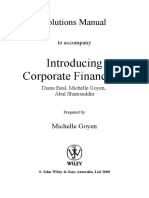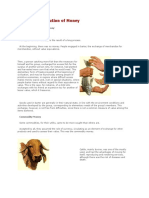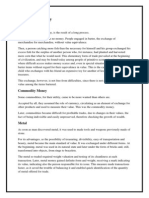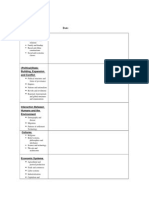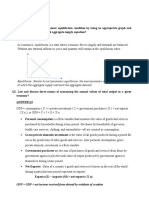The Hidden History of Money & New World Order Usury Secrets Revealed at Last! Page 24
The Hidden History of Money & New World Order Usury Secrets Revealed at Last! Page 24
Uploaded by
foro35Copyright:
Available Formats
The Hidden History of Money & New World Order Usury Secrets Revealed at Last! Page 24
The Hidden History of Money & New World Order Usury Secrets Revealed at Last! Page 24
Uploaded by
foro35Original Description:
Original Title
Copyright
Available Formats
Share this document
Did you find this document useful?
Is this content inappropriate?
Copyright:
Available Formats
The Hidden History of Money & New World Order Usury Secrets Revealed at Last! Page 24
The Hidden History of Money & New World Order Usury Secrets Revealed at Last! Page 24
Uploaded by
foro35Copyright:
Available Formats
to counterfeit objects that could be made. It is highly unlikely that there were formal markets in 75,000 B.C.
(any more
than there are in recently observed hunter-gatherer cultures). Nevertheless, proto-money would have been useful in
reducing the costs of less frequent transactions that were crucial to hunter-gatherer cultures, especially bride purchase,
splitting property upon death, tribute, and intertribal trade in hunting ground rights (“starvation insurance”) and
implements. In the absence of a medium of exchange, all of these transactions suffer from the basic problem of barter --
they require an improbable coincidence of wants or events. Shells of the pea-sized snail Nassarius kraussianus. Blombos
Cave, South Africa, 75,000 B.C. wear marks indicate the shells were strung on a necklace.
In cultures of any era that lack money, barter and some system of in-kind "credit" or "gift exchange" would be the only
ways to exchange goods. Bartering has several problems on small transactions, most notably timing constraints. If
you wish to trade fruit for wheat, you can only do this when the fruit and wheat are both available at the same time and
place. That may be a very brief time, or it may be never. With an intermediate commodity (whether it be shells, rum,
gold, etc.) you can sell your fruit when it is ripe and take the intermediate commodity. You can then use the intermediate
commodity to buy wheat when the wheat harvest comes in. Thus the use of money makes all commodities become more
liquid. Where trade is common, barter systems usually lead quite rapidly to the emergence of several key goods with
monetary properties. In the early British colony of New South Wales in Australia, rum emerged quite soon after
settlement as the most monetary of goods. When a nation is without a fiat currency system, it is quite common for the
fiat currency of a neighboring nation to emerge as the dominant monetary good. In some prisons where conventional
money is prohibited it is quite common for goods such as cigarettes to take on a monetary quality. Gold has emerged
naturally from the world of barter again and again to take on a monetary function. It should be noted that the
emergence of monetary goods is not dependent on central authority or government. It is a quite natural
market phenomenon.
The first instances of money were objects which were useful for their intrinsic value. This was known as commodity money
and included any commonly-available commodity that has intrinsic value; historical examples include pigs, rare seashells,
whale's teeth, and (often) cattle. In medieval Iraq, bread was used as an early form of currency. Spices have been used
as commodity money for long. Definite indications are available that both black and white pepper have been used as
commodity money for hundreds of years before Yeshuah-Jesus-Issa, as also several centuries thereafter. Being a valuable
commodity, pepper has naturally been used as payment. Attila the Hun reportedly demanded 3,000 pounds in weight of
pepper in 408 AD as part of a ransom for the city of Rome. In the Middle Ages, there was a French saying, 'As dear as
pepper'. In England, rent could be paid in pounds of pepper, and so a symbolic minimal amount is known as a
"peppercorn rent". Even in the industrialized world, in the absence of other types of money, people have occasionally used
commodities such as tobacco as money. This last happened on a wide scale after World War II when cigarettes became
used unofficially in Europe, in parallel with other currencies, for a short time. Precious metals have been a common form
of money, such as this gold from Sveriges Riksbank.
Another example of "commodity money" is shell money in the Solomon Islands. Shells are painstakingly chipped into
rough circles, filed down, and threaded onto large necklaces, which are then used during marriage proposals; for instance,
a father may charge twenty shell money necklaces for his daughter's hand in marriage. One interesting example of
commodity money is the huge limestone coins from the Micronesian island of Yap, quarried at great peril from a source
several hundred miles away. The value of the coin was determined by its size — the largest of which could range from
nine to twelve feet in diameter and weigh several tons. Displaying a large coin, often outside one's home, was a
considerable status symbol and source of prestige in that society. (Due to the great inconvenience, islanders would often
trade only promises of ownership of an individual coin instead of actually moving it. In some cases, coins which had been
lost at sea were still used for exchange in this way. These agreements could be thought of as a kind of representative
money, described below.) An example is the 8-foot "coin" from the village of Gachpar, on Yap.
Once a commodity becomes used as money, it takes on a value that is often a bit different from what the
commodity is intrinsically worth or useful for. Being able to use something as money in a society adds an extra use
to it, and so adds value to it. This extra use is a convention of society, and how extensive the use of money is within the
society will affect the value of the monetary commodity. So although commodity money is real, it should not be seen as
having a fixed value in absolute terms. Its value is still socially determined to a large extent. A prime example is gold,
which has been valued differently by many different societies, but perhaps none valued it more than those who used it as
money. Fluctuations in the value of commodity money can be strongly influenced by supply and demand
whether current or predicted (if a local gold mine is about to run out of ore, the relative market value of gold
may go up in anticipation of a shortage).
Money can be anything that the parties agree is tradable, but the usability of a particular sort of money varies widely.
Desirable features of a good basis for money include being able to be stored for long periods of time, dense so it can be
carried around easily, and difficult to find on its own so that it is actually worth something. Again, supply and demand play
a key role in determining value. Metals like gold and silver have been used as commodity money for thousands of years,
being in the form of metal dust, nuggets, rings, bracelets and assorted pieces. Eventually the Lydians began coining
gold and silver around 560 BC. Gold and silver are both quite soft metals, and coins minted from the pure
metals suffer from wear or deformation in daily use. Fortunately these metals are also easily alloyed with a less
expensive metal, frequently copper, in order to improve the durability of the resulting coins. Typically alloys of coinage
metals, such as sterling silver or 22 carat (92%) gold, are used to make coins more durable. These are alloys of 90% or
more precious metal as alloys of less than 90% do not improve hardness or durability very much, and so are typically
considered to be on the slippery slope into monetary debasement.
The Hidden History Of Money & New World Order Usury Secrets Revealed at last! Page 24
You might also like
- The Encyclopedia of Roman Imperial CoinsDocument653 pagesThe Encyclopedia of Roman Imperial CoinsDCLXVI93% (15)
- Solutions Manual: Introducing Corporate Finance 2eDocument29 pagesSolutions Manual: Introducing Corporate Finance 2ePaul Sau HutaNo ratings yet
- Commodity MoneyDocument28 pagesCommodity MoneyVenn Bacus RabadonNo ratings yet
- Research, 5, 2006, 149-165 (In Chinese Translation) ) 1.introduction: Money, East and WestDocument15 pagesResearch, 5, 2006, 149-165 (In Chinese Translation) ) 1.introduction: Money, East and Westmaximos74No ratings yet
- Czajka - Said & African OrientalismDocument14 pagesCzajka - Said & African OrientalismDavid M. W.No ratings yet
- A Short History of MoneyDocument22 pagesA Short History of MoneygonzomarxNo ratings yet
- Commodity MoneyDocument5 pagesCommodity Moneyhasan jamiNo ratings yet
- History of MoneyDocument9 pagesHistory of MoneymoufkirNo ratings yet
- Origin and Evolution of MoneyDocument8 pagesOrigin and Evolution of MoneyChinthani SooriyamudaliNo ratings yet
- Origin and Evolution of MoneyDocument6 pagesOrigin and Evolution of MoneyTauseef AhmedNo ratings yet
- What Is MoneyDocument19 pagesWhat Is MoneyBill McNallyNo ratings yet
- Credit/Floating/Fiat Money: The Hidden History of Money & New World Order Usury Secrets Revealed at Last! Page 25Document1 pageCredit/Floating/Fiat Money: The Hidden History of Money & New World Order Usury Secrets Revealed at Last! Page 25foro35No ratings yet
- " Money and Its History": AboutDocument13 pages" Money and Its History": AboutHarsha ShivannaNo ratings yet
- Money SPEECHDocument1 pageMoney SPEECHHamza khanNo ratings yet
- The History of MoneyDocument2 pagesThe History of Moneyekadestra21No ratings yet
- Gold The Forever CurrencyDocument5 pagesGold The Forever CurrencydumbmeNo ratings yet
- What Is Money? by A. Mitchell InnesDocument30 pagesWhat Is Money? by A. Mitchell InnesAsepdehNo ratings yet
- Mitchell Innes, A - What Is MoneyDocument22 pagesMitchell Innes, A - What Is MoneylarsrordamNo ratings yet
- (History of Money) : Kimberly M. Cruz IV-Bethlehem Mrs. Geraldine LimDocument7 pages(History of Money) : Kimberly M. Cruz IV-Bethlehem Mrs. Geraldine LimKim CruzÜNo ratings yet
- What Is Money?: by A. Mitchell InnesDocument35 pagesWhat Is Money?: by A. Mitchell InnesLorena MariaNo ratings yet
- Commodity Money Is Money Whose Value ComesDocument5 pagesCommodity Money Is Money Whose Value Comeshasan jamiNo ratings yet
- Referensi Sejarah UangDocument18 pagesReferensi Sejarah UangNurul AimNo ratings yet
- Types of Money: Money Is Any Object or Record That Is GenerallyDocument5 pagesTypes of Money: Money Is Any Object or Record That Is GenerallyAngelNo ratings yet
- How Money Began - Comprehension IELTS 5Document6 pagesHow Money Began - Comprehension IELTS 5wohlamhayNo ratings yet
- Laurence H Meyer: The Future of Money and of Monetary PolicyDocument14 pagesLaurence H Meyer: The Future of Money and of Monetary PolicyFlaviub23No ratings yet
- Inflation J Deflation J Fiat MoneyDocument18 pagesInflation J Deflation J Fiat MoneyhelenbattenhbNo ratings yet
- JW Smith - Economic DemocracyDocument31 pagesJW Smith - Economic DemocracyjeykumaranNo ratings yet
- What Was The Price of Gold Then? Importance, Measurement, and HistoryDocument7 pagesWhat Was The Price of Gold Then? Importance, Measurement, and HistoryAnurag KesarwaniNo ratings yet
- Banking Chapter 1Document12 pagesBanking Chapter 1ADHAM SAFINo ratings yet
- 10 Things That Make A Gold Rush A "Gold Rush"Document2 pages10 Things That Make A Gold Rush A "Gold Rush"aBBy DayawenNo ratings yet
- Bullion MarketDocument48 pagesBullion MarketsmitNo ratings yet
- 6 MoneyDocument2 pages6 MoneyTiniko TulashviliNo ratings yet
- The ultimate beginners guide to the basics of coin collectionFrom EverandThe ultimate beginners guide to the basics of coin collectionNo ratings yet
- An Introduction To Archaic CoinageDocument23 pagesAn Introduction To Archaic CoinageronaldoggpereiraNo ratings yet
- Types of MoneyDocument4 pagesTypes of MoneyAlexandraNo ratings yet
- Gold StandardDocument8 pagesGold StandardSwapnil Singh ThakurNo ratings yet
- what_is_moneyDocument17 pageswhat_is_moneyRodérigo Tonilaõs AdejaírNo ratings yet
- Evalution of MoneyDocument3 pagesEvalution of MoneyPrincess GeminiNo ratings yet
- HindeSight June 2010 Gold The Currency of First ResortDocument6 pagesHindeSight June 2010 Gold The Currency of First Resortbenjaminsurfer100% (1)
- Hinde Capital June 2010Document6 pagesHinde Capital June 2010ZerohedgeNo ratings yet
- Money Medium ExchangeDocument4 pagesMoney Medium ExchangeNilufer AllahyarliNo ratings yet
- Funda & BF PTDocument10 pagesFunda & BF PTReign AlfonsoNo ratings yet
- Project - Evolution of Money - From Commodities To E-MoneyDocument10 pagesProject - Evolution of Money - From Commodities To E-MoneyENTITYPLAYZZNo ratings yet
- What is “Money” and Why YOU Should Care About Bitcoin: A guide to Bitcoin and Self-CustodyFrom EverandWhat is “Money” and Why YOU Should Care About Bitcoin: A guide to Bitcoin and Self-CustodyNo ratings yet
- MONEY IN THE NA-WPS OfficeDocument20 pagesMONEY IN THE NA-WPS OfficeAbigailNo ratings yet
- A No Fluff Beginners Guide to Coin Collecting 2023 - 2024: A Simplified Guide to Identify and invest in Rare and Error CoinsFrom EverandA No Fluff Beginners Guide to Coin Collecting 2023 - 2024: A Simplified Guide to Identify and invest in Rare and Error CoinsNo ratings yet
- History of MoneyDocument22 pagesHistory of MoneyLulu Racpan100% (1)
- TEXT History of MoneyDocument10 pagesTEXT History of Moneypoly 2004No ratings yet
- Coin Finds in Britain: A Collector’s GuideFrom EverandCoin Finds in Britain: A Collector’s GuideRating: 5 out of 5 stars5/5 (1)
- Coins and CurrencyDocument1 pageCoins and CurrencymetroknightNo ratings yet
- Gresham's Law: Gresham's Law Is Commonly Stated: "Bad Money Drives Out Good", But Is More Accurately Stated: "Bad MoneyDocument6 pagesGresham's Law: Gresham's Law Is Commonly Stated: "Bad Money Drives Out Good", But Is More Accurately Stated: "Bad MoneyJosé María Bravo LinerosNo ratings yet
- History of Foreign ExchangeDocument3 pagesHistory of Foreign ExchangeEkjon DiptoNo ratings yet
- The Encyclopedia of Roman Imperial Coins (2005)Document653 pagesThe Encyclopedia of Roman Imperial Coins (2005)daniel bertti jr.100% (1)
- Understanding Gold by PaulDocument22 pagesUnderstanding Gold by PaulRahul Murthi100% (1)
- Cash in On The CrashDocument43 pagesCash in On The CrashSaratNo ratings yet
- WWW - Referat.ro Monetary Systemd5ca2Document58 pagesWWW - Referat.ro Monetary Systemd5ca2Timothy McclureNo ratings yet
- Money: Research ShowcaseDocument20 pagesMoney: Research ShowcaseJames PavurNo ratings yet
- Gold CoinDocument7 pagesGold Coinhasan jamiNo ratings yet
- The Secret Subtle Laws of The UniverseDocument2 pagesThe Secret Subtle Laws of The Universeforo35No ratings yet
- In Short, I Was A Racketeer, A Gangster For (Monopoly) Capitalism (TS)Document1 pageIn Short, I Was A Racketeer, A Gangster For (Monopoly) Capitalism (TS)foro35No ratings yet
- Subtle Secrets eBOOK - Unlocked (Dragged)Document1 pageSubtle Secrets eBOOK - Unlocked (Dragged)foro35No ratings yet
- Subtle Secrets eBOOK - Unlocked (Dragged) 3Document1 pageSubtle Secrets eBOOK - Unlocked (Dragged) 3foro35No ratings yet
- The Secret Burial: The Hidden History of Money & New World Order Usury Secrets Revealed at Last! Page 29Document1 pageThe Secret Burial: The Hidden History of Money & New World Order Usury Secrets Revealed at Last! Page 29foro35No ratings yet
- Credit/Floating/Fiat Money: The Hidden History of Money & New World Order Usury Secrets Revealed at Last! Page 25Document1 pageCredit/Floating/Fiat Money: The Hidden History of Money & New World Order Usury Secrets Revealed at Last! Page 25foro35No ratings yet
- Money, Being Naturally Barren, To Make It Breed Money Is Preposterous and A Perversion From The End of Its Institution, Which Was Only To Serve The Purpose of Exchange and Not of IncreaseDocument1 pageMoney, Being Naturally Barren, To Make It Breed Money Is Preposterous and A Perversion From The End of Its Institution, Which Was Only To Serve The Purpose of Exchange and Not of Increaseforo35No ratings yet
- The Hidden History of Money & New World Order Usury Secrets Revealed at Last! Page 14Document1 pageThe Hidden History of Money & New World Order Usury Secrets Revealed at Last! Page 14foro35No ratings yet
- Why Your Government Is Either A Thief or You Are A "Public Officer" For Income Tax Purposes 18 of 220Document1 pageWhy Your Government Is Either A Thief or You Are A "Public Officer" For Income Tax Purposes 18 of 220foro35No ratings yet
- Why Your Government Is Either A Thief or You Are A "Public Officer" For Income Tax Purposes 14 of 220Document1 pageWhy Your Government Is Either A Thief or You Are A "Public Officer" For Income Tax Purposes 14 of 220foro35No ratings yet
- List of Tables: Why Your Government Is Either A Thief or You Are A "Public Officer" For Income Tax Purposes 4 of 220Document1 pageList of Tables: Why Your Government Is Either A Thief or You Are A "Public Officer" For Income Tax Purposes 4 of 220foro35No ratings yet
- Why Your Government Is Either A Thief or You Are A "Public Officer" For Income Tax Purposes 12 of 220Document1 pageWhy Your Government Is Either A Thief or You Are A "Public Officer" For Income Tax Purposes 12 of 220foro35No ratings yet
- Regulations: Why Your Government Is Either A Thief or You Are A "Public Officer" For Income Tax Purposes 9 of 220Document1 pageRegulations: Why Your Government Is Either A Thief or You Are A "Public Officer" For Income Tax Purposes 9 of 220foro35No ratings yet
- Verified Gross Mass Weight CertificationDocument1 pageVerified Gross Mass Weight CertificationCobianu Ioana AlinaNo ratings yet
- Embracing Digital in Trade Finance: Working PaperDocument17 pagesEmbracing Digital in Trade Finance: Working Paperchi nguyenNo ratings yet
- EF3A HDT Import Export FDI FPI PCB11Document45 pagesEF3A HDT Import Export FDI FPI PCB11Sai AmithNo ratings yet
- Pink and Purple Minimalist Illustrated Career Plan Presentation (Mobile-First)Document20 pagesPink and Purple Minimalist Illustrated Career Plan Presentation (Mobile-First)varshagk24No ratings yet
- REVIEWERDocument23 pagesREVIEWERBerba, Ace Daryl J.No ratings yet
- Soal Test (Dragged)Document3 pagesSoal Test (Dragged)Salsabila Aufa100% (1)
- Technology, An Ally or An Enemy?: Floored Movie ReviewDocument4 pagesTechnology, An Ally or An Enemy?: Floored Movie ReviewAllen Kyle MagundayaoNo ratings yet
- Tax Invoice/Bill of Supply/Cash Memo: (Original For Recipient)Document1 pageTax Invoice/Bill of Supply/Cash Memo: (Original For Recipient)harshim guptaNo ratings yet
- Spice ChartDocument10 pagesSpice Chartapi-296326751100% (1)
- Inventory Cases - Sessions 3 & 4Document23 pagesInventory Cases - Sessions 3 & 4akansha.associate.workNo ratings yet
- Formatierte Incoming Nachricht MT 700 ILCUSC1871917 1/1 TRIQIQBAXXX SWIFTDocument4 pagesFormatierte Incoming Nachricht MT 700 ILCUSC1871917 1/1 TRIQIQBAXXX SWIFTErosNo ratings yet
- Lecture 14Document57 pagesLecture 14Billiee ButccherNo ratings yet
- Percent (%) : When We Say "Percent", We Are Really Saying "Per 100". One Percent (1%) Means 1 Per 100Document17 pagesPercent (%) : When We Say "Percent", We Are Really Saying "Per 100". One Percent (1%) Means 1 Per 100Khaing PhyuNo ratings yet
- BL + CO + Inv + Pack 113840470Document10 pagesBL + CO + Inv + Pack 113840470Đàn NguyễnNo ratings yet
- Santosh Project Ajc College 1Document28 pagesSantosh Project Ajc College 1routh3177No ratings yet
- Turkish Pol Economy (1980-1989)Document15 pagesTurkish Pol Economy (1980-1989)caltac17No ratings yet
- SC4 W1 Role Function & Types of InventoryDocument6 pagesSC4 W1 Role Function & Types of InventoryLiz BelasaNo ratings yet
- Shipper (Pengirim) Shipper'S Declaration For Dangerous Goods (Pernyataan Pengirim Untuk Barang Berbahaya)Document1 pageShipper (Pengirim) Shipper'S Declaration For Dangerous Goods (Pernyataan Pengirim Untuk Barang Berbahaya)Edgar KadunNo ratings yet
- Sub Order LabelsDocument10 pagesSub Order LabelsHimanshu Kr. BhumiharNo ratings yet
- Definition of Product Groups Used in Part A.2: Agricultural Products (Ag)Document3 pagesDefinition of Product Groups Used in Part A.2: Agricultural Products (Ag)rain06021992No ratings yet
- challanform9TH BIODocument1 pagechallanform9TH BIOferozabad schoolNo ratings yet
- New GSTDocument91 pagesNew GSTUTSAV MISHRANo ratings yet
- Assignment: Answer Q1Document6 pagesAssignment: Answer Q1kindye fekade75% (4)
- Role of Commercial Bank-1Document9 pagesRole of Commercial Bank-1TanzeemNo ratings yet
- Estmt - 2023 06 12Document8 pagesEstmt - 2023 06 12skstro.cNo ratings yet
- Base de Wallets Elite TRADERSDocument7 pagesBase de Wallets Elite TRADERSalbasequerabaNo ratings yet
- Principles of GSTand Customs Law - Chapter1Document5 pagesPrinciples of GSTand Customs Law - Chapter1Aniket SharmaNo ratings yet
- 04 Cash Book and Subsidiary BooksDocument11 pages04 Cash Book and Subsidiary BooksDhruv GuptaNo ratings yet

